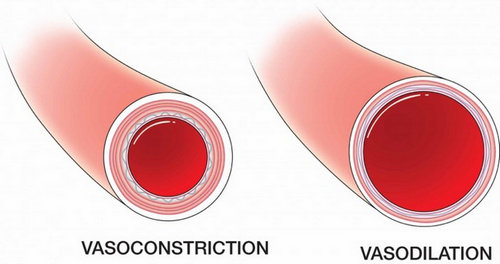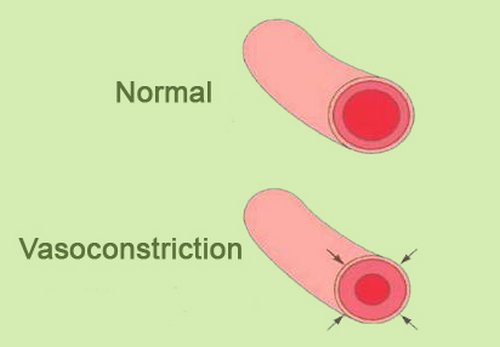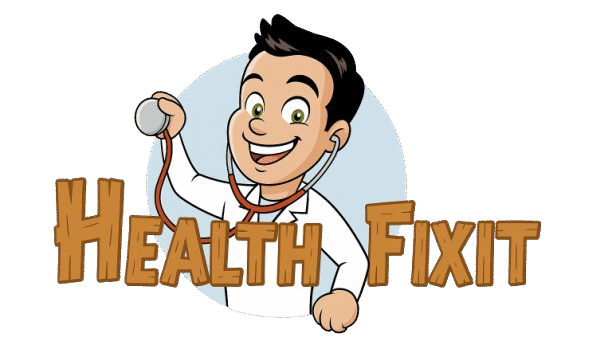What is vasoconstriction?
It is the narrowing of the blood vessels as the muscular walls of the vessels contract. Vasoconstriction and vasodilation are two different things, although a lot of people used them interchangeably.
Vasodilation is the widening of the blood vessels. It is the opposite of vasoconstriction. It is useful in many circumstances. Vasoconstriction helps stop haemorrhage and prevent acute blood loss. A narrow blood vessel means the blood flow is restricted. There are events where vasoconstriction is helpful, but there are also times when it has negative effect to the body. (1, 2)
Vasoconstriction Symptoms
- Numbness and tingling sensation
- Cramps
- Headache
- Noticeable change in skin color
- High blood pressure
- Imbalance
- Double vision
- Loss of muscle control and/or muscular paralysis
- Slurred speech (2)

Image 1 : A comparison image of a constricted blood vessels and dilated blood vessels
Picture Source : www.physicool.co.uk
 Picture 2 : An image of a blood vessel.
Picture 2 : An image of a blood vessel.
Photo Source : 1.bp.blogspot.com
 Figure 3 : Vasoconstriction in the form of cold therapy which is significantly useful for athletes
Figure 3 : Vasoconstriction in the form of cold therapy which is significantly useful for athletes
Image Source : www.therapypoints.com
What causes vasoconstriction?
Vasoconstriction causes are vast. Vasoconstriction and blood pressure are very much related. As the blood vessels constrict, the normal flow of blood will be altered, which leads to blood pressure spike. If the blood vessels keep on constricting, it could lead to chronic high blood pressure, which puts the patient at risk for heart attack and stroke. Vasoconstriction causes include the following: (3)
- Caffeinated foods and drinks – The usual foods that you eat on a day to day basis can actually cause narrowing of the blood vessels. Examples are coffee, tea, soda, energy drink, and chocolates. Too much consumption of these foods can trigger vasoconstriction. (3)
- Salty foods – Sodium leads to water retention, which in turn increases the volume of blood and constricts the vessels. Those people with high salty diet are prone to vasoconstriction, which could lead to chronic hypertension. Reduce you sodium intake by eating real foods and not the ones you buy from fast food chains. Eat processed foods in moderation. Examples are canned soup, pizza, fries, frozen dinners, and canned corned beef and meat loaf. Some condiments and breakfast cereals may have a high sodium level too. (4)
- Bad cholesterol – Stay away from foods containing saturated fat and trans fat. They contain bad cholesterol and they have a negative effect to blood circulation and heart health. To prevent vasoconstriction, you should choose foods with healthy cholesterol. Sources of good cholesterol include fish like salmon and trout, edible seeds and nuts, soybean oil, avocado, canola oil, and shellfish.
- Refined carbohydrates – An intake of food that can rapidly raise the glucose level of the body can cause vasoconstriction. Examples are white bread and white pasta. Refined carbs alone are not the exact cause of vasoconstriction, but they can aggravate the condition. If you are a heavy coffee drinker and you indulge in refined carbs, bad cholesterol, and unhealthy foods, then it makes you susceptible to vasoconstriction.
- Sedentary lifestyle – Vices like chronic smoking and excessive alcohol drinking can put you at risk for vasoconstriction. The same thing goes for substance abuse like cocaine, nicotine, and stimulants. (4, 5)
- Side effects of medicines – Some drugs cause the blood vessels to constrict. Vasoconstrictor drugs include decongestants, epinephrine, norepinephrine, vasopressin, phenylephrine, and pseudoephedrine. (5)
What is peripheral vasoconstriction?
It is the physiologic response of the body. It allows the body to retain core heat longer, which is very helpful in case of hypothermia. The skin acts as insulating layer between the body organs and the water.
Of all parts of the body, only the head is not affected by peripheral vasoconstriction. In other words, you are more likely to lose body heat in the head, neck, and upper chest area. (6)
What is hypoxic pulmonary vasoconstriction?
It is the response of the smooth muscles of the pulmonary artery. It resulted in a reduced flow of blood in the presence of a reduced alveolar oxygen pressure.
This mechanism helps maintain a normal V/Q relationships by simply directing the blood from under ventilated areas. It is also known as von Euler-Liljestrand mechanism. An impaired hypoxic pulmonary vasoconstriction could lead to hypoxemia (low concentration of oxygen in the blood).
Vasoconstriction in sport
Vasoconstriction is useful in promoting healing in sports-related injury. Cold therapy is used in relieving pain in the injured muscles. It causes vasoconstriction on the injury site. It reduces swelling and bleeding.
As the blood vessels constrict, the metabolism slows down, which leads to less cellular death and speedy recovery. Vasoconstriction thermoregulation is useful in athletes competing in a cold environment such as ice skaters, cross country skiers, and speed skaters. If the body is exposed in a cold environment, it will constrict the blood vessels to keep the core temperature of the body. (6, 7)
How to treat vasoconstriction?
Once you notice the early sign of vasoconstriction, you need to treat it right away. Vasoconstriction treatment should focus on the root cause of the problem. Vasoconstriction constricts the blood vessels, which decreases the flow of blood.
Hence, the goal of the treatment is to dilate the vessels. Medicines that widen the blood vessels include calcium channel blockers and alpha adrenoceptor antagonists.
Aside from these drugs, there are natural ways to widen the blood vessels and promote proper blood circulation. Examples are cardiovascular exercises, limiting the exposure to stress and cold, and avoiding caffeinated beverages and nicotine. (8, 9, 10)
It is a must to treat the underlying condition. If you are suffering from peripheral artery disease, there is a tendency that the blood vessels constrict. To widen the blood vessel, the doctor usually prescribe statins.
If you experience any of the symptoms mentioned above, you can somehow relieve the symptoms by massaging the affected area for about 10 minutes. By simply massaging the area, you will be able to increase the flow of blood will temporarily reverse the effect of vasoconstriction.
You should keep your body healthy at all times. Eat a well-balanced meal, keep your weight within normal range, and get plenty of sleep. (10)
References:
- https://en.wikipedia.org
- www.medicinenet.com
- diseasespictures.com
- www.normalbreathing.com
- www.ncbi.nlm.nih.gov
- www.reference.com
- www.rightdiagnosis.com
- erj.ersjournals.com
- www.phaonlineuniv.org
- www.sciencedirect.com
